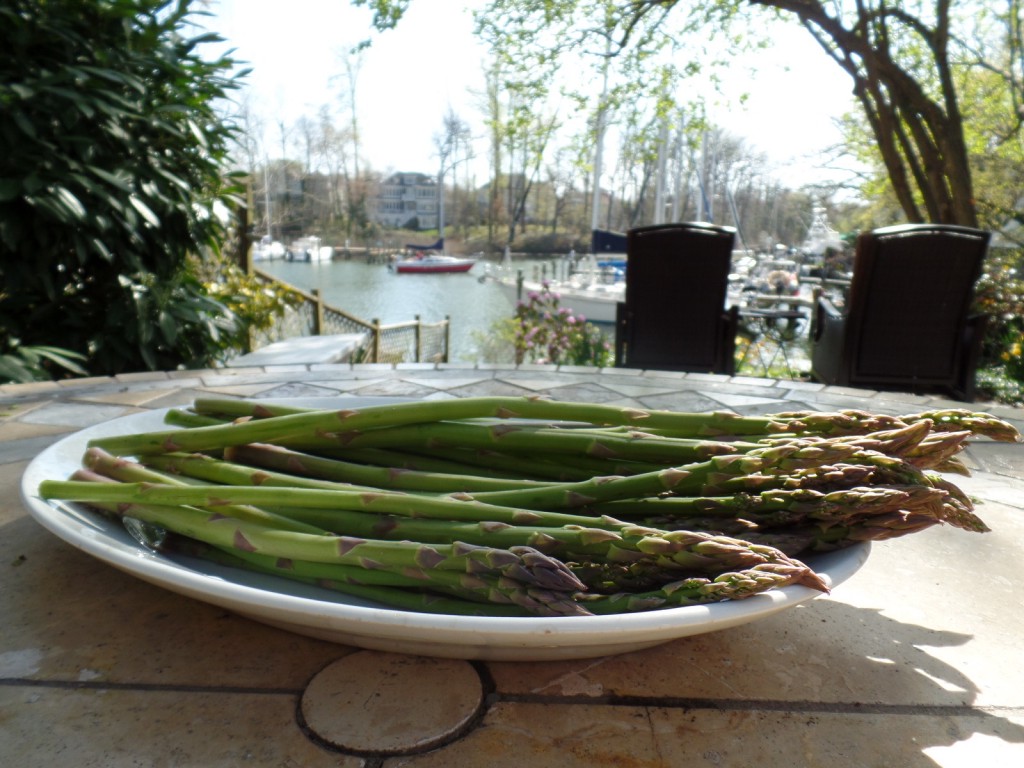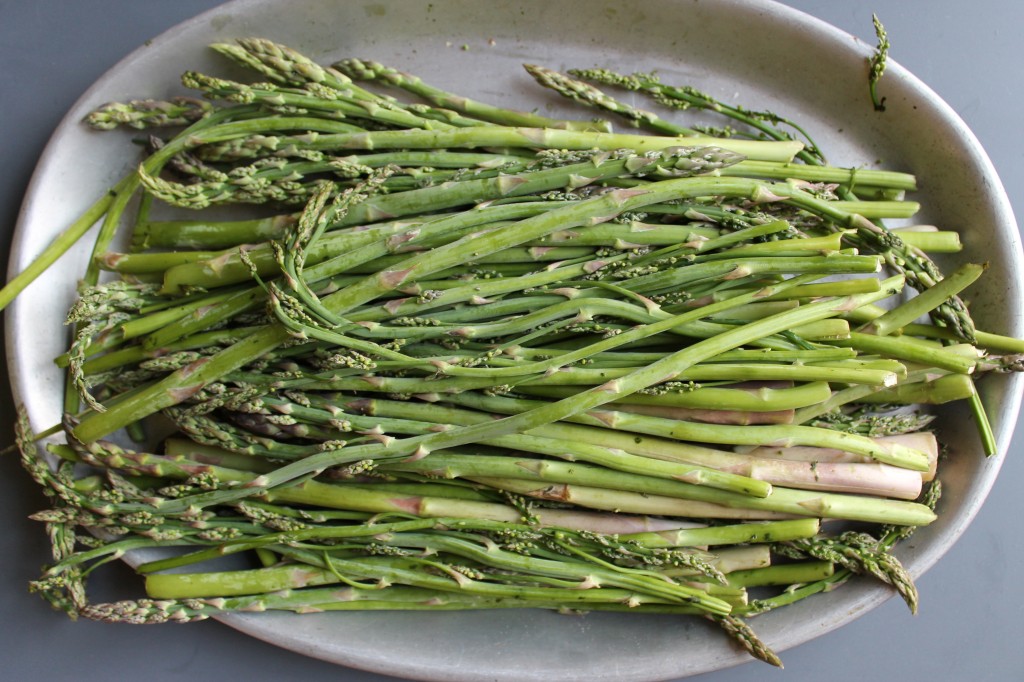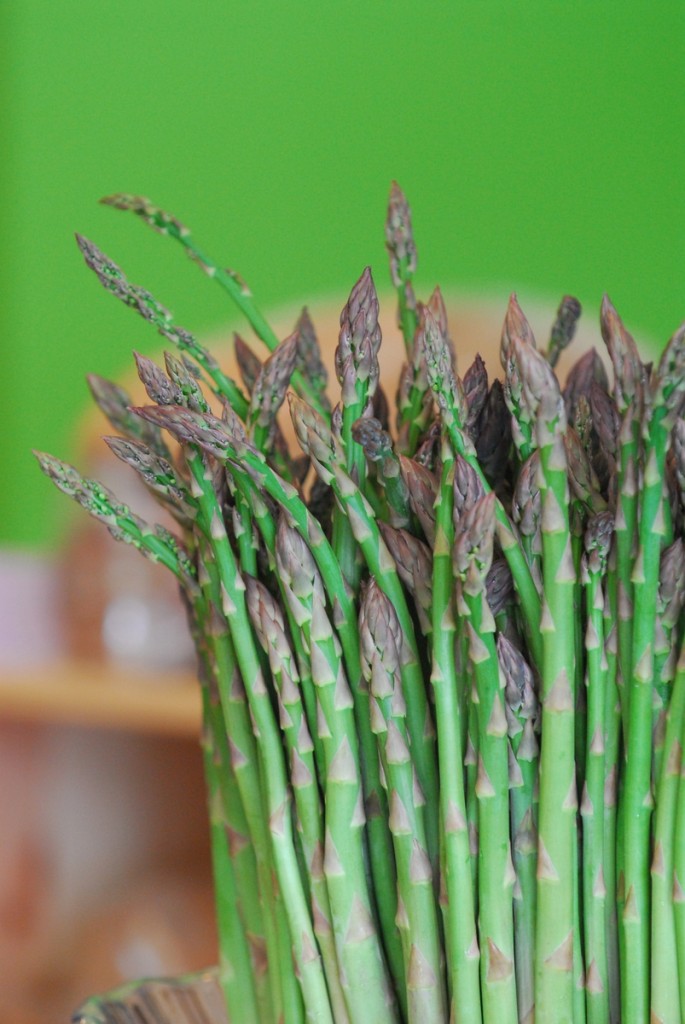By Eugenia Bone, author of The Kitchen Ecosystem, special to Edible Communities

When my son was very young he was a binge eater. One fall he ate tomatoes and apples. Just tomatoes and apples. The following winter it was ground beef. But after a full Spring of his eating pretty much nothing but baked asparagus, which he nibbled from top to bottom, I became exasperated and asked his doctor if these eating habits were going to cause malnutrition or…or what? But Dr. Heiss put my worries aside. He said the whole idea of a daily food requirement was bogus (and some say a government-supported fiction perpetrated by the food industry lobby), and that a good diet only makes sense from an annual perspective. Over the course of a year, at the rate my son was going, his diet was perfectly fine. I started to think about this, and how much sense it makes in terms of eating seasonally. What nature wants us to do is binge on fresh, regional foods at their nutritional peak. How much nutrition are you getting from asparagus picked in Chile in December and shipped thousands of miles? Better to eat and preserve them now, while the wild (well, not exactly wild, as Asparagus officinalis are feral: they’re escaped domestic asparagus) and cultivated asparagus are in their glory.
Wild asparagus grow pretty much all over the country. You’ll find them along fence lines, ditches, and roads; though avoid roadsides where you suspect there may have been weed spraying. Once you locate a patch you’ll be able to harvest these perennials every year. (It’s easy to locate a patch before everything starts greening up as they stand out from other weeds. For guidance, check out http://hungerandthirstforlife.blogspot.com/2014/03/identifying-year-old-wild-asparagus.html) The tender shoots or spears come up in the spring, and as the temperature warms, the plant become ferny and bushy, eventually producing little red berries (which are inedible). Wild asparagus can be anywhere from a foot high to as tall as you, and the spears can be stringy and tough, but the flavor! It was wild asparagus that opened my mind to the byproducts that could be made with asparagus.
Cultivated asparagus are sold thick and thin, and vary in color from white to green to purple. White asparagus are blanched by mounding earth around the plant to protect it from the sun. Interestingly, people either seem to love them or hate them. (I love them poached in stock, with sautéed morels on top.) Thick asparagus come from older plants or early harvests, and thin asparagus come from younger plants or later harvests, as the new asparagus shoots become thinner as the season progresses. (By the way, the distinct smell of your pee after eating asparagus is a result of metabolizing certain compounds in the asparagus. The younger the asparagus you eat, the stronger the smell.)
I prefer thick asparagus as the texture holds up better under cooking and canning, and I like the purple cultivars the most, as they are especially sweet and tender, though if you pickle them they stain the vinegar purple. It’s okay. Weird, but okay. Look for firm stalks with tight tips. Once the buds start to open the spear quickly becomes woody. Store asparagus in a jar of water in the fridge as you would cut flowers. If you ask me, they’re just as beautiful.
You don’t need to peel asparagus unless the stems are tough, and then, only the lower half of the asparagus. So how much of the spear to use? You can use it all. To trim asparagus, either peel the tough end, and cut off the dry tip, or snap the spears. Hold the ends of the asparagus and gently bend. It will break at the point where the tender part of the asparagus ends. The tougher end of the spear has plenty of flavor, and can be used to make an aromatic stock. You can use the stock many ways: as a soup base (it’s a fabulous base for fish soup), as a poaching liquid for fish, to make risotto, and to cook spaghettini.
Cooked with fish or eggs, pickled and used in place of capers in dishes like Chicken Piccata, poached and dressed with homemade mayonnaise, or simply baked and drizzled with oil and Parmesan cheese, asparagus are a real seasonal treat. I pig out on them when they are in, especially in conjunction with other spring foods, like lamb, morel mushrooms, and soft shell crabs, and vegetable plates with artichokes, peas, and ramps. Not only are they delicious, but I know binging is the best way to access their great nutritional profile. At least, that’s what the doctor told me.

Shaved Asparagus, Pea, and Pea Shoot Salad
I have served this surprisingly rich salad as a second course after a pasta dish, on top of a piece of broiled fish, and garnished with croutons: they’re all good! When choosing pea shoots, look for small pale leaves with plenty of thin, curling tendrils. Avoid large stemmy pea shoots, which are tougher. But if you do find them in the market with very long stems you can cut the stems off and throw them in the stockpot. Save the asparagus ends or peels for Asparagus Stock (below).
SERVES 4
1½ cups shelled fresh peas (about 1 pound in the shell)
12 thick spears asparagus, trimmed (as described in text above)
1 large garlic clove, smashed and peeled
½ teaspoon mustard powder
1 teaspoon fresh lemon juice
1 whole anchovy (see Note), chopped
2 tablespoons olive oil
¼ pound pea shoots
Salt and freshly ground black pepper
1 tablespoon grated Parmesan cheese
In a pot of boiling water, cook the peas until tender, about 10 minutes. Drain. Using a very sharp knife (or a mandolin if you have one) cut the asparagus into very thin slivers on an angle. Raw asparagus must be very thinly sliced to be palatable.
Rub the garlic clove around the inside of a wooden bowl. Add the mustard powder and lemon juice. Mix until the mustard powder dissolves. Add the anchovy and combine well.
Add the oil, mixing all the while. Add the peas, asparagus, and pea shoots and toss in the dressing. Season with salt and pepper to taste and toss with the Parmesan cheese.
Note: I prefer whole anchovies cured in salt, which you can find in Italian markets. Soak them for 10 minutes to remove the salt, then rinse and fillet them. You don’t have to get all the bones, just the spine.

Asparagus Pesto
This puree is great to have on hand. It makes an excellent sauce for broiled fish or for pasta or ravioli, or a poached egg on an English muffin. With added cream and seasoning, it’s also perfect as a warm soup. It is not thick, but loose and light. To make this pesto more robust, add 1/3 cup pine nuts to the food processor. Save the asparagus cooking water and ends or peels for Asparagus Stock (recipe below).
MAKES 1 PINT
1 pound asparagus, trimmed (as described in text above)
1/3 cup pine nuts (optional)
2 garlic cloves, sliced
2 tablespoons olive oil
4 teaspoons fresh lemon juice
Salt
Cut the asparagus in large pieces and place them in a large pot. Add just enough water to barely cover and bring to a boil over high heat.
Reduce the heat to medium, cover, and boil the asparagus gently until they are fork-tender, about 10 minutes for slender asparagus, longer for thick ones. Reserving the cooking water, drain the asparagus.
Place the asparagus in a food processor along with 1/4 cup of the reserved cooking water and the garlic. Add the pine nuts, if using, the oil, lemon juice, and salt to taste and pulse to combine. If necessary, add a bit more cooking water to get a smooth pesto.
The asparagus pesto holds in the freezer for 8 to 12 months. Add salt and pepper as you use the pesto (seasoning loses its oomph when frozen).
Spaghettini with Asparagus Pesto
SERVES 4
If you have asparagus pesto on hand you always have a quick dinner. This pasta dish is elegant, beautiful as a first course or a light dinner. For an extra savory dish, cook the pasta in chicken broth (see side bar). You can also jazz up the garnishes: try sautéed shrimp, a dollop of homemade ricotta, or chopped fresh chives, or a combination.
¾ lb spaghettini
1 heaping cup asparagus pesto (recipe above), warmed
Salt and freshly ground black pepper to taste
4 tablespoons grated Parmesan or pecorino cheese for garnish
4 tablespoons toasted breadcrumbs
Bring a large pot of salted water to a boil over a high heat. Add the spaghettini and cook until al dente. Drain. In a large serving bowl toss the pasta with the asparagus pesto. Add salt and pepper to taste, and garnish with the grated cheese and breadcrumbs.

Eugenia Bone is a cook and author whose stories and recipes have appeared in newspapers and magazines across the country including The New York Times Magazine to Saveur, Food & Wine, Gourmet, Fine Cooking, The Wine Enthusiast, Martha Stewart Living, and The Wall Street Journal, among many others. She is the author of 5 books, among them Italian Family Dining, and Well Preserved: Recipes and Techniques for Putting Up Small Batches of Seasonal Food (nominated for a James Beard award); Mycophilia: Revelations from the Weird World of Mushrooms, and The Kitchen Ecosystem: Integrating Recipes to Create Delicious Meals. Visit Eugenia's blog, TheKitchenEcosystem.com.








